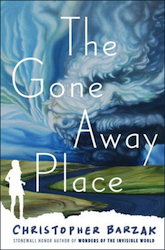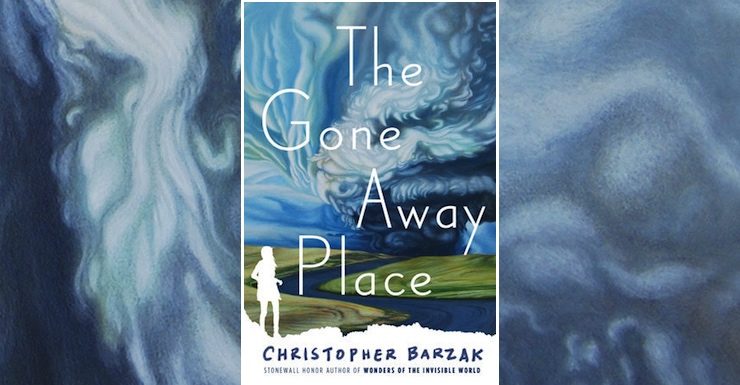A sudden outbreak of tornadoes devastates Ellie Frame’s small Ohio town one spring morning, killing more than ninety people—including her best friends and her boyfriend who were trapped at the high school while she was skipping classes. However, those who were lost in the storm still linger, their ghosts haunting the town and their loved ones, unable to move past the liminal space Newfoundland has become.
The Gone Away Place collects the testaments of Ellie, her parents, and various ghosts as she tries to make sense of her own survival in the face of unfathomable destruction.
Wonders of the Invisible World (reviewed here), Barzak’s previous novel, was also set in rural Ohio; both employ the intimate and sometimes-suffocating setting of a small town to great effect and both explore the dangers of coming of age through a violent trauma.
Buy the Book


The Gone Away Place
The Gone Away Place is more of a meditation on loss than it is a novel. Though there is a plot of sorts—Ellie seeking out her boyfriend Noah’s absentee ghost, the grey area between life and death that has settled over Newfoundland temporarily—it is rudimentary at best. Barzak’s concern is the thematic arc as laid out in the words of Eva Arroyo, the community counselor who comes to assist the town in its processing:
You have a place inside you that has been hurt. Or maybe destroyed is how it might feel. A gone away place. A place you must heal. A place you must fill again. There are only two ways to do this that I know of. One is to remember the story you were a part of before the place inside you was destroyed, and begin to live within that story again. Or, if that doesn’t seem possible, you must start a new story to live within. And the only way to do either of these is to begin talking. To begin telling your story, even if you’re unsure of it at the beginning.
The various vignettes that form the text of the novel are all, in a sense, versions of this project. Each character must construct a narrative for their experiences and their emotions, their destruction, to grow past it. The longest and most frequent of these is Ellie’s. Her record is labelled “The Last Will and Testament of Ellie Frame” in each of her chapters, and as her tale evolves, we move with her through the stages of grief and guilt.
After all, the reason Ellie survived the tornadoes though her friends and classmates didn’t is that she fought with her boyfriend Noah over a jealous response to his care for his (female) loner neighbor. She stormed off to spend the morning napping at the town lighthouse and witnessed, from a distance, the destruction of her town. Her survivor’s guilt is powerful, especially when faced with the parents of her dead friends and the dead friends themselves in spirit.
Spoilers ahead.
The metaphor of owning a story to escape it—to be freed from it to make something new—is made literal with the ghosts themselves. Ellie discovers that she is able to record a testament from a ghost, a memory that sustained them or a piece of themselves they want to leave behind, and once she’s done so they’ll pass on to the next stage of being. As the novel progresses, she does this for her various friends, in the process rescuing one from an emotionally abusive mother. The vignettes give the reader brief insights into the young, unfinished lives of Ellie and her friends as she helps them pass on and helps herself let go of them.
Again: it’s more of a thought experiment or an illustration of concept than a traditionally plotted novel. Barzak’s approach is intimate and careful. He renders his fictional teenagers with intense care to their woes and dreams, the awfulness of their deaths, the horror of parents who outlast their children. The Gone Away Place offers a reflection on recovering from trauma while sketching the stories of its characters’ lives—a fight here, a secret there, an adult world out of reach for the teenagers about to graduate and grow forward.
As for the adult themselves, Ingrid’s mother was a fascinating portrait of an grown person with ulterior motives. I also appreciated Rose’s parents and their traditional approach to maintaining her ghost until she’s able to pass on. The adults are developed in short but thorough glimpses, in some ways invisible to their children but not the reader. Ellie’s parents adore her without losing their own individual characters: a father who pretended he didn’t see ghosts at first, a mother who volunteers too long at the shelters to assuage her own guilt as having a child survive. The inclusion of these adult stories adds nuance to the exploration of what it means to try and process a sudden loss.
What The Gone Away Place isn’t, though, is a balanced book. Noah’s absence is the oddest part of the text. It’s required to create the final emotional confrontation between Ingrid and Elli over Noah, to therefore allow Ingrid to move on from her passion for her sole friend… but it isn’t necessarily believable. The conclusion, wherein Ingrid abruptly gives up her plan to possess Ellie, reads off-kilter. In a book driven thoroughly by emotional development rather than traditional narrative plot, the sudden appearance of a “threat” like cruel possession rings false. However, even once it becomes a potential danger, it dissolves just as fast. While the ultimate conclusion is moving and thoughtful, the climax feels forced—and that’s hard to recover from effectively.
Barzak has created an illustrative guide–a narrative metaphor—for loss and trauma, growth and recovery. His ability to render individual humans alive on the page is captivating, particularly when it comes to the world of small-town Ohio. While the novel is unsuccessful in terms of its attempt to balance plot and theme, it is nonetheless an intriguing and intimate emotional project doing work that I found engaging, especially for a young-adult audience.
The Gone Away Place is available May 15th from Knopf Books for Young Readers.
Lee Mandelo is a writer, critic, and editor whose primary fields of interest are speculative fiction and queer literature, especially when the two coincide. They have two books out, Beyond Binary: Genderqueer and Sexually Fluid Speculative Fiction and We Wuz Pushed: On Joanna Russ and Radical Truth-telling, and in the past have edited for publications like Strange Horizons Magazine. Other work has been featured in magazines such as Stone Telling, Clarkesworld, Apex, and Ideomancer.










